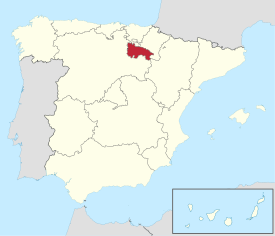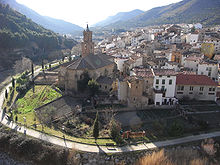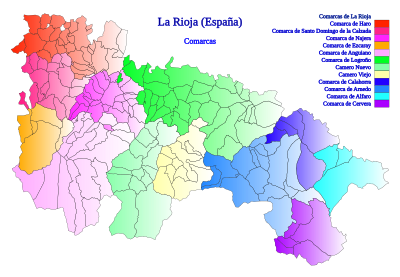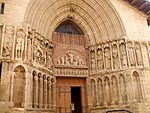La Rioja
This article needs additional citations for verification. (October 2022) |
La Rioja | |
|---|---|
| La Rioja (in Spanish) | |
| Anthem: Anthem of La Rioja | |
 Location of La Rioja within Spain | |
| Coordinates: 42°15′N 2°30′W / 42.250°N 2.500°W | |
| Country | Spain |
| Capital | Logroño |
| Government | |
| • President | Gonzalo Capellán (PP) |
| Area (1.0% of Spain; Ranked 16th) | |
• Total | 5,045 km2 (1,948 sq mi) |
| Population (2018) | |
• Total | 315,675 |
| • Density | 63/km2 (160/sq mi) |
| • Pop. rank | 17th |
| • Percent | 0.7% of Spain |
| Demonym | |
| • English | Riojan |
| • Spanish | riojano/a |
| GDP | |
| • Total | €9.501 billion (2022) |
| • Per capita | €29,579 (2022) |
| ISO 3166 code | ES-RI[2] |
| Official languages | Spanish |
| Statute of Autonomy | 9 June 1982 |
| Parliament | Parliament of La Rioja |
| Congress seats | 4 (of 350) |
| Senate seats | 4 (of 266) |
| HDI (2021) | 0.910[3] very high · 6th |
| Website | Gobierno de La Rioja |
 | |
La Rioja (Spanish: [la ˈrjoxa]) is an autonomous community and province in Spain, in the north of the Iberian Peninsula. Its capital is Logroño. Other cities and towns in the province include Calahorra, Arnedo, Alfaro, Haro, Santo Domingo de la Calzada, and Nájera. It has an estimated population of 315,675 inhabitants (INE 2018), making it the least populated autonomous community of Spain.
It covers part of the Ebro valley towards its north and the Iberian Range in the south. The community is a single province, so there is no provincial deputation, and it is organized into 174 municipalities. It borders the Basque Country (province of Álava) to the north, Navarre to the northeast, Aragón to the southeast (province of Zaragoza), and Castilla y León to the west and south (provinces of Burgos and Soria).
The area was once occupied by pre-Roman Berones, Pellendones and Vascones. After partial recapture from the Muslims in the early tenth century, the region became part of the Kingdom of Pamplona, later being incorporated into Castile after a century and a half of disputes. From the eighteenth century the Rioja region remained divided between the provinces of Burgos and Soria, until in 1833 the province of Logroño was created, changing the name of the province to La Rioja in 1980 as a prelude to its constitution under a single provincial autonomous community in 1982. The name "Rioja" (from Río Oja) is first attested in 1099.
The region is well known for its wines under the brand Denominación de Origen Calificada Rioja.
History
[edit]

Roman and Muslim periods
[edit]In Roman times, the territory of La Rioja was inhabited by the tribes of the Berones (central country), Autrigones (upper country, extending also north and west of it) and the Vascones (lower country, extending also north and east of it). It was part of the province of Hispania Tarraconensis.
In medieval times, La Rioja was often a disputed territory. The Visigoths created the Duchy of Cantabria that probably included most of La Rioja, as a border march against the Vascones. After the Muslim invasion of AD 711, La Rioja fell into the Muslim domains of Al Andalus.
Medieval period
[edit]Most of the territory was reconquered in 923 by Sancho I of Pamplona, acting for the Kingdom of Pamplona together with the Kingdom of León and the Counts of Castile, feudal lords of the Leonese King. The lower region around Arnedo came under control of his allies the Banu Qasi of Tudela. The territory to the east of the Leza River remained under Muslim control.[citation needed]
Later, there was a dispute between Count Fernán González of Castile and the kings of Pamplona-Navarra, involving great battles. It was decided in favour of the Navarrese after the imprisonment of the Count's family in Cirueña, in 960.[4] La Rioja briefly formed the independent Kingdom of Viguera from 970 to about 1005, at which point it became a part of the Kingdom of Pamplona.[citation needed]
Sancho Garcés moved the capital of the Kingdom of Pamplona to Nájera (La Rioja), creating the so-called kingdom of Nájera-Pamplona which was, due to its large size, the first Spanish Empire.[citation needed] After the independence of Castile in 1035, this new kingdom fiercely fought against Pamplona for the possession of Bureba, La Rioja and other territories. In 1076, after the murder of Sancho IV, Navarre was divided among Castile and Aragon. Castile obtained La Rioja, together with other Navarrese lands.[4] The name "La Rioja" first appears in written records in the Miranda de Ebro charter of 1099. The territory was centred on the fortified site of Logroño: the 12th-century church Iglesia de Santa Maria de Palacio recalls its origin as a chapel of the administrative palace. Logroño was a borderland disputed between the kings of Navarre and the kings of Castile from the 10th century;
From 1134 the Navarrese under García Ramírez ("the Restorer") and his son Sancho VI ("the Wise") fought bitterly with Castile for the recovery of the former Pamplonese domains.[citation needed] The region was awarded to Castile in a judgement by Henry II of England and annexed in 1177. Its importance lay in part in the pilgrimage route to Santiago de Compostela, the Camino de Santiago, which crossed the River Ebro on the stone bridge, the Puente de Piedra.

Province of Logroño
[edit]
In the 18th century, the territory remained divided between the intendences of Burgos and Soria. The region was taken by Napoleonic forces in the Peninsular War and remained solidly in French hands until 1814. In the 1810 project of Llorente it was to be a part of the prefecture of Arlanzón with its capital in Burgos. The Cortes of Cádiz declared La Rioja an independent province at the time of the Liberal Constitution of 1812, and during the Liberal Triennium in January 1822 the province of Logroño was created by royal decree as part of the administrative reform of Riego, taking in the whole of the historical territory of La Rioja. However, Ferdinand VII soon annulled these decisions and restored most of the previous territorial divisions. In the 1833 reorganization, a province of Logroño was again formed within the region of Castilla la Vieja. The province increased its territory temporarily in 1841.
Autonomous community
[edit]In 1980 the province changed its name to La Rioja, and following the adoption of the Estatuto de San Millán in 1982, during the reorganization following the Spanish transition to democracy, it was constituted as a uni-provincial autonomous community.[5] It is the second-smallest autonomous community in Spain and has the smallest population; half of its 174 municipalities have populations under 200. Nearly half of its citizens live in the capital.
Etymology
[edit]The etymology of the toponym Rioja is complex and has been much discussed. The main theories point to different origins: the traditional popular one that makes it correspond to the river Oja, the one that points to the term Rivalia that would be translated as "land of streams", the one that points as germ a nominal tautology in the term rivo Ohia that would mean "river of fluvial bed"; and the very diverse ones that indicate that it would have its origins in the Basque language, for example as union of the words herria and ogia being translated as "land of bread".
Numerous authors from different periods have proposed different theories about it, such as the friar Mateo Anguiano in the 18th century, Ángel Casimiro de Govantes in the 19th century, Menéndez Pidal or Merino Urrutia in the 20th century, or in the 21st century, the researcher Eduardo Aznar Martínez. In addition, there are texts by older authors such as Florián de Ocampo in the 16th century or Rodrigo Méndez Silva in the 17th century, which give an account of the popular etymology of the toponym.
The first written appearances of this toponym as Rioga or Riogam date back to the 11th century, and it can also be found with different spellings such as Rioxa, Riogia, Rivo de Oia, Rivogio or in its definitive form Rioja in texts of later centuries. On the other hand, the oldest document found in which its demonym appears dates from the 13th century, with the spellings riogeñ and riogensi, that is, Riojan (Spanish: riojano).
In the first written appearances of this toponym in the 11th century, the westernmost area of the present-day Spanish region is designated under the same name; therefore, the primitive Rioja was the territory around the basins of the rivers Tirón and Oja, with some divergences in its exact location by different authors. Gradually and as a result of various historical events, the toponym was extended from the Middle Ages, to name a larger region, consisting of seven river valleys, located between the Tirón in the west and the Alhama in the east, which flow into the Ebro, namely La Rioja today.[6]
Geography
[edit]
La Rioja is bordered by the Basque Country (province of Álava), Navarre, Aragón (province of Zaragoza), and Castile and León (provinces of Soria and Burgos). The river Ebro flows through this region, as does the river Oja, after which it is named.
The Ebro runs through the north of the community. The entire right bank (which is to the south) belongs to La Rioja. There are only three municipalities, Briñas, San Vicente de la Sonsierra and Ábalos on the left bank (known as the Riojan Sonsierra), although Logroño, Agoncillo, Alcanadre, Rincón de Soto and Alfaro also have parts of their respective municipal territories on that bank. Because of their proximity[citation needed], the Álava area between the Ebro and the Sierra de Cantabria is called Rioja Alavesa.
Climate
[edit]The climate is mainly continental. The Rioja Alta comarca receives more precipitation than Rioja Baja. The average temperature ranges from 11.8–31.8 °C (53.2–89.2 °F) and the precipitation ranges between 300–500 mm (12–20 in) as an annual average.[7] The wind called Cierzo is very frequent around La Rioja during the winter.
Mountains and mountain ranges
[edit]The mountains in La Rioja are part of the Iberian System. This mountain range extends to the south of the Ebro river, parallel to it at a distance of about 40 to 60 km (25 to 37 miles), with altitudes ranging between 1,000 and 2,000 m (3,300 and 6,600 feet). From the mountain range the Sierra de la Demanda runs northwards, into the heart of La Rioja, incorporating Monte San Lorenzo which, at 2,271 m (7,451 ft), is the highest peak in the province. Other mountains include Sierra de Camero Viejo, Sierra de Camero Nuevo, Sierra de Cebollera, and Picos de Urbión.

|
Hydrography
[edit]
The Ebro is the main river passing through the community. Emerging from the narrow channel between the rocks of the Conchas de Haro, it reaches La Rioja, through which it runs for 120 km (75 miles), before continuing its journey to the Mediterranean. In the Conchas de Haro the altitude of the river is 445 m (1,460 ft) and when it leaves the community, in the Sotos del Ebro Natural Reserve in Alfaro, it is 260 m (850 ft) high. The river therefore flows very quickly through La Rioja.[original research?]
Seven rivers descend rapidly towards the Ebro from the mountain range, which is why La Rioja is sometimes called: "Zone of the seven valleys". They are, from east to west, Alhama, Cidacos, Leza, Iregua, Najerilla, Oja and Tirón, although the headwaters of the Alhama and Cidacos originate in Soria and those of Najerilla-Neila and Tirón are from Burgos. Sometimes Linares (a tributary of Alhama) is added, grouping Tirón with its tributary, the Oja.
All the rivers of these valleys form tributaries that go on to form many valleys in their own right, such as those of Linares, Ocon, Jubera, Tuerto, Brieva, Viniegras and San Millán. There is an almost unlimited number of grandiose canyons, quite splendid in nature, such as Aguas Buenas, Nieva, Manzanares, Ardancha, Navajún, Valderresa, Ollora, Tobia, San Martín and others.
Flora and fauna
[edit]In the highlands, oaks, beech and pine are grown. There are also thickets of juniper, boxwood, sloes, holly and cistus. Thyme, rosemary, common juniper, and holm oak are present. There are grand hillsides with fine pasture for livestock, cattle and sheep. In the lower areas there are oaks, olive and almond trees. Near the Ebro, in the plains, the land is used for cereal, sugar beet and potatoes, while the hills are covered with vast vineyards of the wine that has brought worldwide fame to this region.
All Riojan rivers, including the Ebro, have a row of poplars and cottonwood. About the Riojan Alamos Ana Maria Matute has written: "... see them on the edge of the water, turning the landscape, like spears magical pointing towards the unreal and mysterious country of the riverbed."[8]
Natural resources
[edit]Gypsum and silica are mined. Arnedillo is a spa town.
Dinosaur footprints
[edit]
During the Early Cretaceous period, the geographical area of Cameros was part of a flooded plain that drained periodically, leaving behind muddy areas where dinosaur tracks marked the path. Eventually they were dried and covered with new sediment layers whose weight pressed down on the lower layers, causing them to solidify into rocks over millions of years. Erosion has been wearing down the upper layers making many of these rock formations visible, bringing into view the fossilized footprints. La Rioja is notable for the number and conservation of these sites, in addition to those found in the north of Soria, such as Yanguas, Santa Cruz de Yanguas and other highland locations.[9]
Comarcas
[edit]
Geographical comarcas:
- Rioja Alta
- Rioja Media
- Tierra de Cameros
- Comarca de Logroño
- Rioja Baja
Economy
[edit]The Gross domestic product (GDP) of the autonomous community was 8.5 billion euros in 2018, accounting for 0.7% of Spanish economic output. GDP per capita adjusted for purchasing power was 29,200 euros or 97% of the EU27 average in the same year. The GDP per employee was 102% of the EU average.[10]

La Rioja is known for its production of Rioja DOCa wines (although the Rioja viticultural region extends slightly into the neighboring administrative regions of Álava and Navarra).
Agriculture
[edit]There is dryland farming of wheat, barley and grape; irrigated cultivation of asparagus, capsicum and other crops; and animal husbandry of sheep.
Industry
[edit]Types of industry include wine production and conserves (in Logroño, Cenicero, Haro and Calahorra); textiles and footwear (in Logroño, Arnedo, Cervera del Río Alhama and Ezcaray); furniture manufacturing (in Ezcaray, Logroño and Nájera); rubber, plastics, chemical products and transport machinery; and chorizo, made in Casalarreina.
Exports are directed mostly towards the European Union, United States and Canada.
La Rioja hosts the annual Battle of Wine festival in the village of Haro. Another famous local festival is the Toro de fuego, where a metal frame in the shape of a bull is carried among festival goers, which also takes place in Haro.
Demographics
[edit]According to the INE the population of La Rioja (as at 2018) is 315,675 inhabitants, with 155,758 men and 159,917 women. Its population density is 62.57 people per km2.[11] It is the least populous autonomous community in Spain. Its capital, Logroño, with approximately 151,113 inhabitants, is its most populous city.
La Rioja has 174 municipalities. According to the same INE data, there are more men than women in 150 of them, in two the numbers are the same and in 22 there are more females than males. In the latter set, the differences are small, except in the capital where there are 4,868 more women than men.
| Vertical bar chart demographic of La Rioja between 1857 and 2018 |
 |
| Legal population (1857-1897) according to the population census published by the Instituto Nacional de Estadística in the nineteenth century.
Legal population (1900-1991) or Resident population (2001) according to the population census published by the Instituto Nacional de Estadística.
Population according to the municipal register of 2018 published by the Instituto Nacional de Estadística.
|
Major cities
[edit]| Rank | Name | Pop. | |||||||
|---|---|---|---|---|---|---|---|---|---|
 Logroño  Calahorra |
1 | Logroño | 151,113 |  Arnedo  Haro | |||||
| 2 | Calahorra | 23,923 | |||||||
| 3 | Arnedo | 14,815 | |||||||
| 4 | Haro | 11,309 | |||||||
| 5 | Lardero | 10,193 | |||||||
| 6 | Alfaro | 9,460 | |||||||
| 7 | Nájera | 8,047 | |||||||
| 8 | Villamediana de Iregua | 7,973 | |||||||
| 9 | Santo Domingo de la Calzada | 6,231 | |||||||
| 10 | Autol | 4,469 | |||||||
Education
[edit]According to the 2007 PISA report, education in La Rioja is of the highest quality in Spain, close to that of other European countries with better overall educational levels in terms of student knowledge. In the Ministry of Education's 2009 report La Rioja was in first position among the autonomous communities as it relates to general aspects of primary and secondary education.[13]
It is placed above the Spanish average in the list of communities with the lowest levels of school failure, with 85% of students being able to obtain the ESO title, despite its schools having the highest proportion of enrolled immigrants.[14]
6,208 euros are spent per pupil, making it the tenth ranked community in this regard.[13] The majority of educational institutions in the community are public, followed by subsidized and private schools, the latter of which are very scarce at the primary and secondary levels. The bachillerato is free in public schools and at a cost in charter schools.[15]
In La Rioja the portion of the population with higher education is 30.6%, with two institutions offering studies at this level: the University of La Rioja and an online university, the International University of La Rioja.[16]
Transportation
[edit]
La Rioja has connections by air via the Logroño-Agoncillo Airport.
Rail journeys to Madrid, Zaragoza, Barcelona, Valladolid, Oviedo, Bilbao, La Coruña, Vigo are possible, since the Castejón-Miranda line crosses the region from east to west. The main railway station is that at Logroño.
Roads between La Rioja and neighboring regions are primarily through the AP-68. Additional highways have been built, such as the Autovía A-12 which connects Pamplona to Logroño since 2006, and in the future will reach Burgos. Other major road routes include:
Government and politics
[edit]The current President of La Rioja is Gonzalo Capellán of PP. The autonomous community has its own Parliament. Other organs include the Consejo de Gobierno (council of government) and the Tribunal Superior de Justicia (high court of justice).
Monuments
[edit]- Monastery of Santa María la Real of Najera
- Concatedral de Santa María de la Redonda
- Catedral de Santo Domingo de la Calzada
- Iglesia de Santo Tomás
- Abbey of Santa María de San Salvador of Cañas
-
Portal of Church of San Bartolomé (Logroño)
Notable people
[edit]
- Ángel Iturriaga Barco
- Celso Morga Iruzubieta
- Dani Aranzubia
- Domingo de Silos
- Fausto Elhuyar
- Fortunato Pablo Urcey
- Francisco Javier de Lizana y Beaumont
- Gonzalo de Berceo
- Gustavo Bueno
- José Ortiz-Echagüe
- Juan José Elhuyar
- Manuel Bretón de los Herreros
- Martín Fernández de Navarrete
- Práxedes Mateo Sagasta
See also
[edit]- List of presidents of the Parliament of La Rioja
- Dulzaina, a popular musical instrument from La Rioja.
- Jota (music), a popular dance practiced in some comarcas of La Rioja.
- Caparrones, one of the most important dishes in Riojan cooking.
- History of Rioja wine
- Etymology of La Rioja
References
[edit]- ^ "Contabilidad Regional de España" (PDF). www.ine.es.
- ^ "ISO 3166-2 NEWSLETTER Date issued: 2010-02-03 No II-1 Corrected and reissued 2010-02-19" (PDF). Iso.org. Retrieved 13 January 2018.
- ^ "Sub-national HDI - Area Database - Global Data Lab". hdi.globaldatalab.org. Retrieved June 24, 2023.
- ^ a b Javier García Turza. La Rioja entre Navarra y Castilla. Del mundo agrario al espacio urbano. Archived from the original on 8 October 2018. Retrieved 12 January 2013.
- ^ "Gobierno de la Rioja". Archived from the original on 2007-04-17. Retrieved 2007-04-07. Statute of Autonomy (in Spanish)
- ^ Granado Hijelmo, Ignacio (1993). "Chapter 2: 2.2. El nombre de "La Rioja"". La Rioja como sistema (in Spanish). Vol. III. Gobierno de La Rioja. pp. 1702–1703. ISBN 84-8125-033-3.
- ^ "weather in la rioja" (in Spanish). Retrieved 29 January 2024.
- ^ "Guía de La Rioja" (PDF). Archived from the original (PDF) on 3 March 2016. Retrieved 12 January 2013.
- ^ "Fósiles de La Rioja permiten reconstruir totalmente el dinosaurio 'Baryonix' (Fossils of La Rioja allow the full reconstruction of the 'Baryonix' dinosaur)" (in Spanish). 26 July 2006.
- ^ "Regional GDP per capita ranged from 30% to 263% of the EU average in 2018". Eurostat.
- ^ "Datos de población por municipios del INE (INE population data by municipalities)" (in Spanish). Archived from the original on 2012-11-14. Retrieved 2013-01-11.
- ^ "Continuous Register Population by Population Unit".
- ^ a b V. Soto (21 April 2010). "La Rioja mantiene la mejor educación de España tras la evaluación de diagnóstico del Ministerio" (in Spanish). Logroño. Retrieved 11 January 2013.
- ^ Juan Antonio Gómez Trinidad (1 February 2006). "El fracaso escolar en La Rioja es del 15%" (in Spanish). Retrieved 11 January 2013.
- ^ Valeriano Sarto Fraj (21 September 2009). "El concierto de Bachillerato para no segregar" (in Spanish). Retrieved 11 January 2013.
- ^ Website of UNIR - International University of La Rioja. Retrieved 15 May 2017. See also Spanish Wikipedia article.
External links
[edit]- Government of La Rioja Archived 2002-02-21 at the Wayback Machine (in Spanish)
- Tourism in La Rioja








